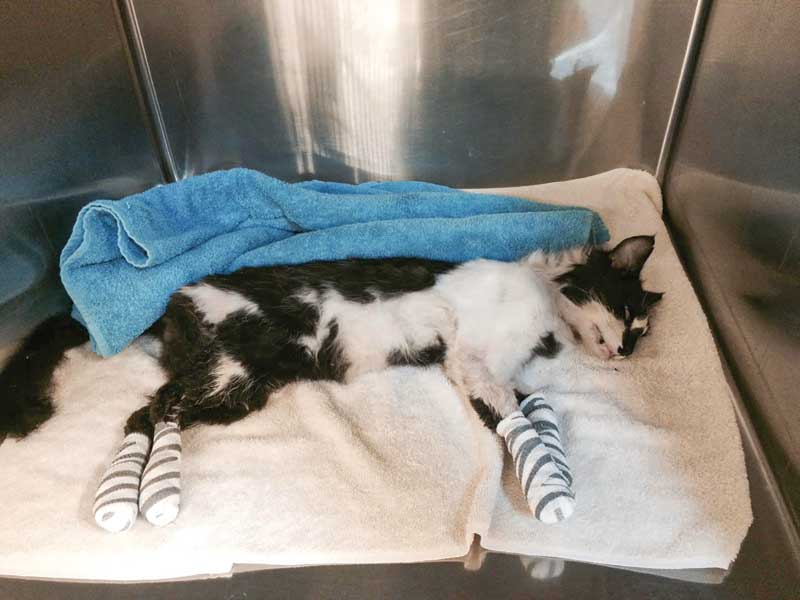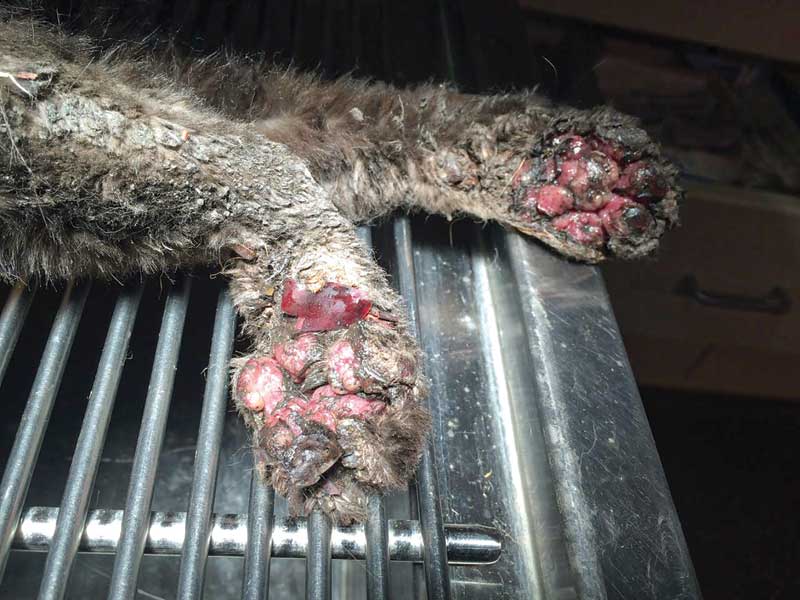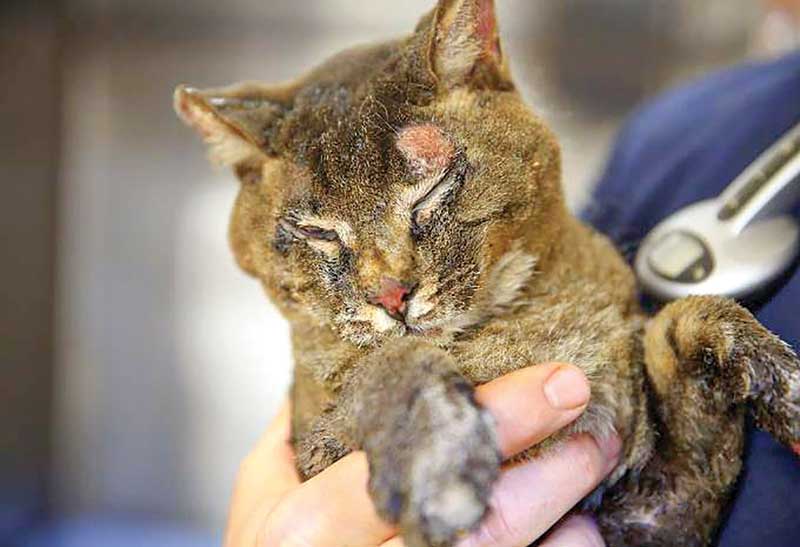Although burn injuries do not rank among the most common veterinarians encounter in their practices, they may see more of them in coming years. Wildfires are occurring more frequently, and summers are becoming hotter, increasing the risk of dogs burning their paws on hot asphalt and cement.
In addition to wildfires, burn injuries can be caused by house fires, outdoor fires, caustic chemicals, scalding water, electrical injuries, hot radiators, side effects of radiation treatment, and other situations where animals come into contact with fire or extreme heat. No matter the cause, just as with human patients, treating burn injuries in animals consists of managing the systemic effects of the burn injury, ensuring adequate nutrition and fluid intake, dressing the wounds, debriding dead tissue, and managing pain.
“We first evaluate the cardiovascular, respiratory, and neurological systems to see if they have life-threatening changes, and once more stable, we determine the size and depth of the injury,” says Deborah Mandell, VMD, professor of emergency and critical care medicine at the University of Pennsylvania (UPenn) School of Veterinary Medicine.
The first few hours are critical, Dr. Mandell says, because skin retains heat for four hours and the burn injury can continue to worsen during that time. Ensuring adequate fluid therapy is also crucial to maintain adequate tissue perfusion during the first 12-24 hours due to the release of cytokine and inflammatory mediators.
“It can take days for the extent of the injury to become apparent, and during that time the cardiovascular, respiratory, and metabolic derangements continue. They can become hypotensive, hypovolemic, anemic, and they can have electrolyte derangement, and develop sepsis progressing to multiple organ dysfunction,” Mandell says.
A cold-water lavage applied during the first few hours can limit the spread of the burn injury.
“You want to do cold water lavage for about 30 minutes, but you do have to be careful you’re not making them hypothermic. Animals don’t always come to us within two hours, but you have to the best you can in the timeframe you have,” she says.
One method1 used to calculate the extent of the burn injury is the veterinary burn card method. The size of the wound is measured using burn cards, which are about the size of a credit card. The number of cards needed to cover the wound is multiplied by 0.45 and divided by the animal’s weigh in meters squared.
“The rule of thumb is if it’s greater than 20 percent of their total body surface area, there will be serious life-threatening cardiovascular and metabolic derangement,” Mandell says.
Once the animal is stabilized, focus turns to dressings, daily bandage changes, debridement, infection control, and pain management, she adds.
Silver sulfadiazine (SSD) is often used as a dressing to prevent infection and promote healing, but other dressings, such as aloe vera, medicinal honey, nanocrystalline silver or cerium nitrate with SSD are also used.
Jeff Smith, DVM, regional coordinator for the California Veterinary Medical Reserve Corps (CVMRC), which treats animals injured in wildfires and other disasters, says CVMRC veterinarians have used silver-infused bandages as an alternate to SSD, with good results.
“This change is much more supportive of the healing tissue while still being a very effective anti-infective,” says Dr. Smith.
After the wildfire that destroyed Lahaina, HI, in August 2023, the Maui Humane Society treated dozens of cats that had burn injuries to their ears, feet, and eyes, along with a dog, a rabbit, and guinea pigs. For dressings, the staff used SSD, SSD with insulin, and honey, says Laurie Gaines, DVM, MHS, Maui Humane Society medical director.

Multimodal approach to management
Pain management is crucial and a multimodal approach targeting different pain receptors works better than using just one drug.
Burned cats injured in California wildfires are usually given a combination of an opioid, such as buprenorphine, gabapentin, and an NSAID, such as meloxicam. Pain in dogs with burn injuries is often managed with a multi-modal combination like acetaminophen, codeine, gabapentin, and an N-methyl-D-aspartate (NMDA) inhibitor (amantadine), says Dr. Smith.
Controlling pain was key to treating the cats burned in the Lahaina wildfire, says Dr. Gaines. Staff and volunteers came in around the clock to give the animals doses of their pain medication. The drugs were supplemented with acupuncture and lasers2 as adjunct pain control methods. “We had a laser donated to us, and that worked really well,” says Gaines. “We used it with the paws when we were doing the bandage changes.”
Special attention had to be paid to the cats with burn injuries on their paws, says Gaines. Their toes melted or fused together, and fur and fur cells trapped in the spaces where their toes used to be, causing pain to the animals, and requiring the amputation of the tissue.
Multiple approaches to debridement
Several different techniques can be used to debride burn wounds, including autolytic, enzymatic, mechanical, or surgical approaches. Ultrasonic and high-pressure water debridement are newer methods, but they are more expensive, Mandell says.
Maggots are another method of wound debridement. The treatment was used successfully at Lloyd Veterinary Medical Center at Iowa State University to debride wounds on a bully breed dog that had incurred second- and third-degree burns on 50 percent of its body after burning gasoline splashed on her skin.
The primary care veterinarian had treated the dog for a few days and stabilized it before it was brought to Lloyd, where the veterinary team decided to use medical-grade maggots to debride her wounds.
While maggots have been used for decades to debride wounds in human burn injury patients, they have not been used as much in veterinary practices due to cost and time constraints, says April Blong, DVM, associate professor of veterinary clinical sciences at Iowa State, who was one of the authors of the paper3 documenting the case.
“Maggots have special enzymes to break down dead tissue and they don’t consume living, viable tissue. We applied the maggots and that helped quite a bit in the debridement process,” says Dr. Blong. Approximately 1,500 maggots were placed over the wound and covered with a semipermeable dressing and bandages. The dog showed some discomfort during the process, requiring an increase in pain medication, but overall did well. “She was very patient with us,” says Blong.
The dog has burn wounds 20 cm to 30 cm across, which was too large for new skin cells to grow across the entire wound, so the team used an acellular cod skin graft to cover the wound and facilitate new skin growth. Almost two years after the dog was injured, new skin had completely grown over its wounds.

Lessons learned
The two veterinarians who have treated animals injured in the California and Maui wildfires say they and their teams have learned helpful lessons to apply when treating animals with burn injuries in the future.
Dr. Smith says the CVMRC team has determined it is critical to stabilize the animals and then transfer them as quickly as possible to veterinarian facilities where they can receive long-term care.
“One of the early mistakes was going through this very formalized protocol, which is not practical in the field. You often have to manage the patient you are seeing with a different sort of triage philosophy than if they were coming into your own veterinary clinic and get them moved on to a proper hospital,” says Smith.

Gaines says her team learned the importance of reaching out for guidance from veterinarians who have experience treating burn injuries. Throughout the weeks and months the Maui Humane Society staff were caring for rescued animals with burn injuries, they were in close contact with veterinary surgeons on Oahu, as well as veterinarians on the mainland who have treated animals injured in wildfires.
Finally, veterinarians who have treated animals with burn injuries say there is much to be learned and replicated from care provided to human burn patients.
“Maybe we don’t see as many burn patients as in humans, but the way human burn patients are treated is leaps and bounds ahead of animals and there is a lot we can learn and borrow from them,” Blong says.
Julie A. Jacob is a communications professional and writer who often contributes to Veterinary Practice News. She lives in Wisconsin with her poodle.
References
- Hampshire, V. Refining analgesia strategies using lasers. Lab Anim 44, 297–298 (2015).
- Huntingford JL, Petty MC. Evidence-Based Application of Acupuncture for Pain Management in Companion Animal Medicine. Vet Sci. 2022 May 26;9(6):252. doi: 10.3390/vetsci9060252. PMID: 35737304; PMCID: PMC9227989.
- Dawson, K. A., Mickelson, M. A., Blong, A. E., & L. Walton, R. A. (2022). Management of severe burn injuries with novel treatment techniques including maggot debridement and applications of acellular fish skin grafts and autologous skin cell suspension in a dog. Journal of the American Veterinary Medical Association, 260(4), 428-435.



